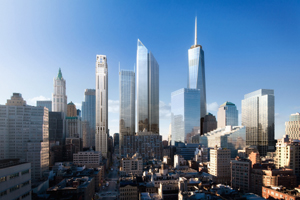Robert A.M. Stern Architects and Silverstein Properties unveiled plans this week for New York City's tallest residential building: an 80-story, 912-foot-tall hotel and condominium tower at 99 Church Street, one block east of the World Trade Center site. A 175-room Four Seasons hotel will occupy the building’s lower 22 stories with 143 condos occupying the upper floors. Although the project joins more than 5,400 residential units and 3,700 hotel rooms already under construction downtown, according to a January 29 article in The Architect’s Newspaper, Stern’s choice of cladding his tower in limestone and cast stone will help it stand out against the increasingly common number of glass-clad towers—taking its cues, instead, from Cass Gilbert’s 1913 Gothic design for the Woolworth Building nearby. “It will be taller, but it’s like in color, and its fenestration pattern and needlelike shape are comparable to the Woolworth Building’s,” Stern told the paper. “On the other hand, it’s not in any way intending to be a Gothic building. It will have a strong but subtle presence on the skyline and, I hope, provide a good transition.” Larry Silverstein, who controls many of the new developments slated for the neighborhood, hopes that 99 Church Street will contribute to the revitalization of downtown. But as The New York Times’ City Room blog noted on January 30, a half-century ago the original 99 Church Street—home to Dun & Bradstreet and more recently Moody’s—was intended to do the same thing. Stern himself, writing in New York 1960, described it as “downtown’s first postwar office building of consequence,” although as the Times added “he went on to disparage the ‘stolid massing’ of the 11-story building and its ‘conservative, stripped-down, limestone-clad facades.’” Demolition on the old building is already underway; construction on the new 99 Church Street will begin this June and finish in 2011. No word yet on its cost.
![]()
Listen to a podcast of these headlines and more.
Click the play button to begin | Click here to download

Frank Gehry and developer Forest City Ratner’s massive Atlantic Yards project in Brooklyn could fall victim to the credit crisis, according to a January 28 article in the New York Post. Bruce Ratner is apparently having difficulty securing the $4 billion needed to begin construction on the 22-acre project, which encompasses 16 residential and commercial buildings—including a 620-foot-tall skyscraper that Gehry dubbed “Miss Brooklyn”—as well as an 18,000-seat arena for the Nets basketball team. Goldman Sachs is reportedly in line to be the lead underwriter on several hundred million dollars of bond financing for the arena portion of the project. The Post reported that court papers “reveal for a first time that the biggest development in Brooklyn’s history is in jeopardy because of dragging litigation and a slumping fiscal market. ‘The credit markets are in turmoil at this time. ... There is a serious question as to whether, given the current state of the debt market, the underwriters will be able to proceed with the financing for the arena while the appeal is pending,’ one affidavit says.” The litigation mentioned is a lawsuit filed by community groups who oppose the project and allege that Ratner received state approval in 2006 without a proper environmental review; opponents are also appealing a state decision to use eminent domain to clear parts of the site. While a Ratner executive told the Post that the developer remains committed to the project, the paper noted that the Nets have already postponed their planned move to the new arena from 2009 to 2010—and they may need to postpone it again given the ongoing litigation and money woes.
Newly released images of Zaha Hadid's revised scheme for the London Summer Olympics Aquatic Center reveal that the scaled-back building has sprouted 'wings,' the U.K.'s Building Web site reported on January 30. The revised design still includes the venue's signature central volume shaped like a manta ray or whale, but new wing-like appendages will flank this volume and together contain 15,000 seats. These appendages, which Building describes only as 'stapled on,' will be removed after the 2012 Games leaving the main volume with a permanent capacity of 2,500 seats. The venue was originally to have contained 20,000 seats. According to Building, rising costs have forced Hadid back to the drawing board three times since her design was first unveiled in 2005'despite the fact that construction has already begun. Building reported on January 31 that it could now cost more than $400 million; the venue was originally budgeted at $150 million.

Post a comment to this article
Report Abusive Comment